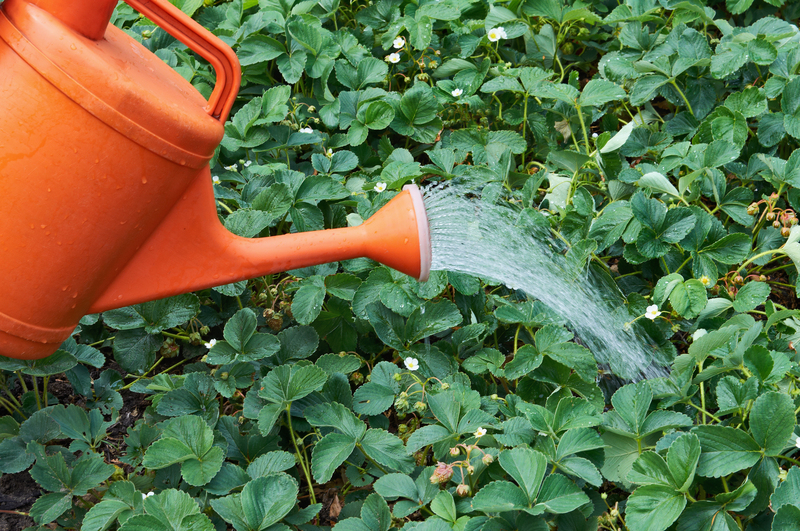Growing a Playful and Engaging Garden for Kids
Posted on 21/06/2025
Growing a Playful and Engaging Garden for Kids
Childhood memories are often rooted in meaningful, hands-on experiences. What better way to nurture a child's curiosity and connection to nature than by creating a playful garden space designed especially for kids? In this comprehensive guide, you'll discover inspiring ideas, practical tips, and creative activities for cultivating a fun, safe, and educational garden that grows alongside your children.
Why Every Child Needs a Playful Garden
Exposure to nature is crucial in today's screen-heavy world. A garden for children is more than just a pretty patch of green - it's an immersive classroom that cultivates essential life skills, including:
- Responsibility: Caring for plants helps kids learn about nurturing and consistency.
- Scientific curiosity: Observing plant growth and insects sparks questions about biology and ecosystems.
- Cognitive development: Problem-solving and planning go hand-in-hand with gardening tasks.
- Sensory exploration: The feel of soil, the smell of herbs, and the taste of homegrown snacks create memorable multi-sensory experiences.
- Emotional well-being: Outdoor play relieves stress and encourages mindfulness.
By growing an inviting garden for kids, you're creating a world of fun, discovery, and social learning right in your own backyard!

Planning Your Kid-Friendly Garden: Where Imagination Grows
1. Choosing the Perfect Location
The first step in creating a child-friendly garden is selecting the right spot. Keep in mind:
- Visibility: Choose an area you can easily supervise from the house.
- Sunlight: Most edible plants need 6-8 hours of sun. Include shaded areas for play and rest.
- Accessibility: Raised beds, wide paths, and containers are great for little hands and feet.
- Safety: Avoid proximity to driveways or water bodies.
2. Designing a Playful and Engaging Space
Think beyond straight rows! Combine interactive play areas with garden beds using some of these creative ideas:
- Secret Hideouts: Willow tunnels, sunflower houses, and tipi trellises make magical spaces for pretend play.
- Stepping Stones: Let kids craft and paint their own garden path markers.
- Edible Mazes: Arrange low hedges or beds of strawberries, herbs, or cherry tomatoes for snacking and adventure.
- Wildlife Corners: Include a bug hotel, bird bath, or butterfly garden to encourage gentle observation of nature.
- Sensory Spots: Fill planters with fuzzy lamb's ear, fragrant mint, or snapdragons for tactile and olfactory fun.
3. Prioritizing Safety in Kids' Gardens
Safety is vital when growing a garden for kids. Consider these precautionary measures:
- Choose non-toxic plants (see below for recommendations).
- Avoid sharp tools and thorny plants near play areas.
- Use organic methods - skip chemical fertilizers and pesticides.
- Fence in the area if wildlife or roads are a concern.
- Teach children garden rules and supervise younger gardeners closely.
Best Plants for a Children's Garden
1. Fast-Growing and Easy Plants
Keeping kids excited means growing plants that deliver quick results! Some great choices include:
- Radishes: Germinate in days and ready to harvest in just 3-4 weeks.
- Sunflowers: Dramatic, fast, and perfect for building flower houses.
- Peas and Beans: Climbing varieties grow up teepees or trellises for picking and snacking.
- Leafy Greens: Spinach, lettuce, and arugula sprout quickly for instant gratification.
- Nasturtiums: Colorful flowers with edible leaves and petals.
2. Sensory and Novelty Plants
- Lamb's Ear: Silky-soft leaves for touching.
- Chocolate Mint: Scented for sniffing and nibbling.
- Snapdragons: Fun to "snap" open the flowers.
- Fennel: Airy fronds and licorice aroma.
- Mimosa Pudica ("Sensitive Plant"): Foliage folds up when touched!
3. Edible Delights
- Strawberries and Blueberries: Sweet and rewarding for little snackers.
- Cherry Tomatoes: Bite-sized and prolific.
- Baby Carrots: Fun to pull from the ground.
- Mini Bell Peppers: Colorful and mild.
Tip: Involve kids in choosing what to plant to give them a sense of ownership and excitement!
Creative Play and Learning Zones
Incorporating areas for play and exploration within your family garden blends learning with laughter. Here's how you can make your garden fun for kids:
1. Digging and Mud Zones
- Create a dedicated digging area filled with loose soil or sand for sensory exploration.
- Add shovels, buckets, and toy construction vehicles to spark imagination.
2. Outdoor Art Studio
- Set up a table for rock painting, nature collages, or DIY plant markers.
- Let children use leaves, flowers, and sticks for craft materials.
3. Fairy or Dinosaur Garden
- Designate a corner for miniature worlds--a fairy house, gnome village, or dinosaur jungle among mossy logs and pebbles.
4. Water and Sensory Play
- Add a simple water table for splashing and experimenting.
- Use safe, shallow basins for tadpole observation or floating flower boats.
5. Reading and Resting Nooks
- Include cozy shaded corners with beanbags, low hammocks, or blankets for relaxing with picture books or snacks.
Fun Kids' Gardening Activities & Learning Experiments
Keep your little gardeners engaged all season long with these educational, hands-on projects:
- Seed Starting Science: Use clear cups to observe sprouting seeds and root growth.
- Pollen Detective: Examine flowers with a magnifying glass and track pollinator visits.
- Garden Journal: Encourage kids to draw, write, or photograph daily garden discoveries.
- Composting Crew: Introduce simple composting, worm farms, or leaf mulching for eco-friendly lessons.
- Plant Math: Count seedlings, measure sunflowers, or sort harvested produce.
- Harvest Feasts: Let kids pick, wash, and prepare their own salads, fruit kabobs, or herbal teas.
- Nature Scavenger Hunt: Make lists of colors, scents, bugs, or leaf shapes to find in the garden.
Tips for Maintaining an Engaging Kids' Garden
Long-term enjoyment comes from keeping the garden thriving and exciting. Use these strategies to keep your playful children's garden fresh and engaging:
- Rotate crops and features each season to introduce new plants and play areas.
- Let kids experiment with their own mini-plots or container gardens.
- Use child-sized tools and gloves for independence and safety.
- Celebrate milestones like "first sunflower bloom" or "biggest pumpkin harvest" with photos and garden parties.
Choosing Safe, Child-Friendly Plants
Always do a safety check before introducing new plants into your garden. Some common ornamentals are toxic if ingested, so stick to these kid-safe favorites:
- Basil, parsley, oregano, sage, and most other culinary herbs.
- Lettuce, spinach, radishes, and beans.
- Sunflowers, pansies, violets, calendula, and nasturtiums.
- Strawberries, blueberries, and raspberries.
- Marigolds and zinnias for pollinator-friendly color.
Plants to avoid in children's gardens: Foxglove, Datura, Oleander, Lily-of-the-valley, and Castor bean - all of which can be toxic if accidentally consumed. Double-check before planting anything unfamiliar.
Accessible Gardening: Including Every Child
A playful, engaging garden for kids should accommodate children of all abilities. Make your space accessible by:
- Building raised beds at different heights for standing or seated access.
- Installing smooth, wide paths for strollers or wheelchairs using bark mulch, gravel, or pavers.
- Offering raised containers, hanging baskets, or vertical gardens for easy reach.
- Providing sensory activities for both visual and non-visual learners (sound tubes, wind chimes, and scented plants are wonderful!)
Bringing Your Playful Kid's Garden to Life
Transforming your family garden into a child-friendly wonderland is a journey that pays long-lasting dividends. Here is a step-by-step summary to help you get started:
- Plan your space with equal focus on play, learning, and plant variety.
- Involve your child at every stage - from drawing garden designs to seed shopping and planting.
- Embrace imperfection! Messy, whimsical corners and unplanned surprises are often the most cherished memories.
- Celebrate every victory, from the first sprout to the last pumpkin harvest.

Frequently Asked Questions: Creating a Children's Garden
1. What are the best months to start a kids' garden?
Spring is ideal for most regions, but fall gardens can also be fun! Indoors, you can start herbs or microgreens anytime for year-round learning.
2. How can I protect the garden from pets or wildlife?
Use low fences, raised beds, or netting for protection. Show kids the tracks and signs of visitors for added learning fun, and plant a few extras "for the bunnies!"
3. How much time should we spend on garden care?
Short, frequent gardening sessions (15-30 minutes, 2-3 times a week) keep things enjoyable and manageable for young children.
4. What tools are best for small hands?
Look for lightweight, child-sized gloves, spades, rakes, and watering cans. Avoid sharp or heavy adult tools.
5. Can apartment dwellers or urban kids have a garden?
Absolutely! Try windowsill planters, balcony containers, vertical pocket gardens, or community garden plots for the same playful benefits.
Conclusion: Growing Memories, One Seed at a Time
A playful and engaging garden for kids is much more than a patch of soil; it is an ever-changing storybook, playground, and science lab all in one. By cultivating a lively outdoor environment rich in color, taste, and texture, you will not only nurture healthy plants, but also the imagination and resilience of your children.
Start small, dream big, and - above all - have fun! With your support, your children's garden will become a cherished place where curiosity, laughter, and lifelong love of nature take root.
Ready to grow an enchanting garden for your kids? Share your successes and ideas in the comments below, and help inspire more families to cultivate a playful connection with nature!

